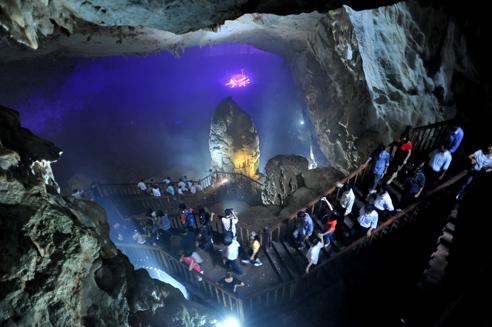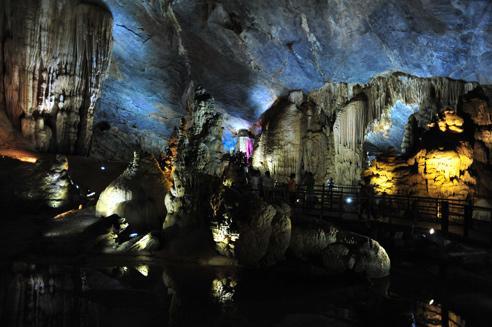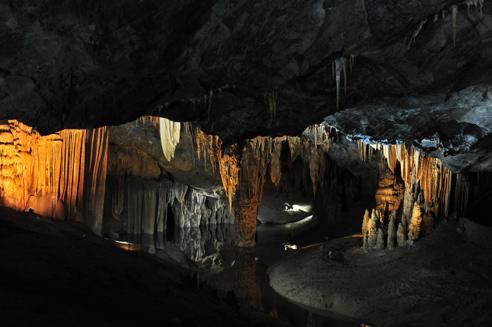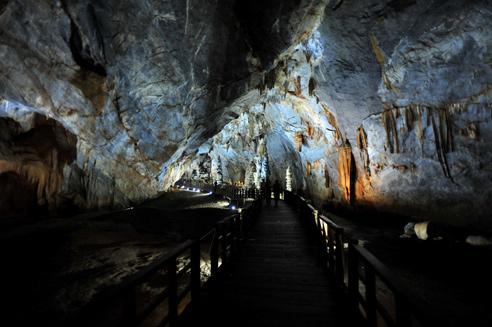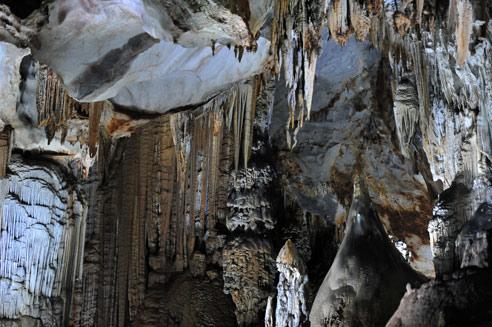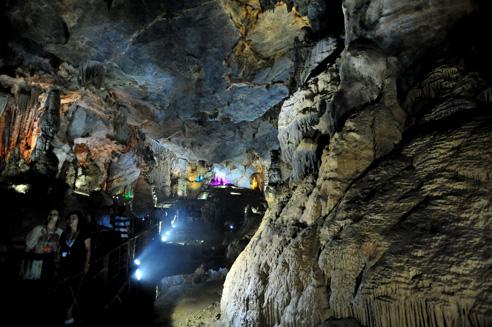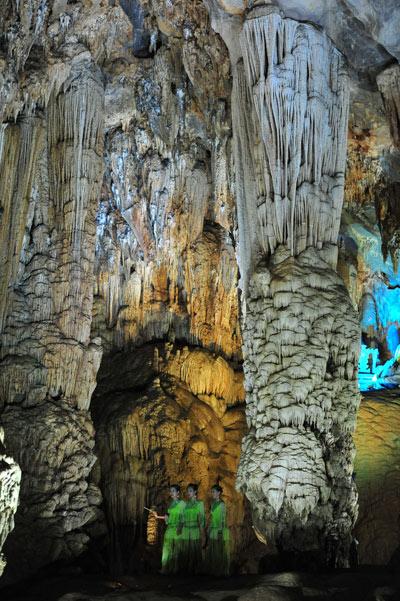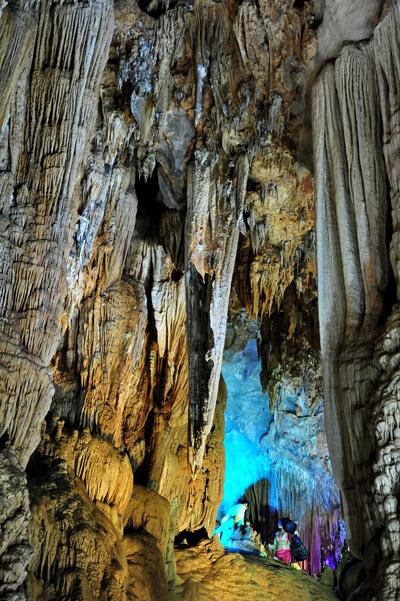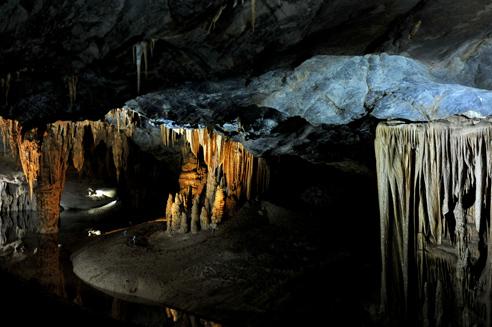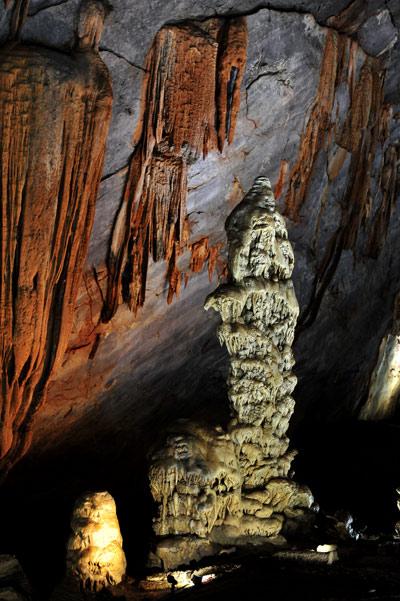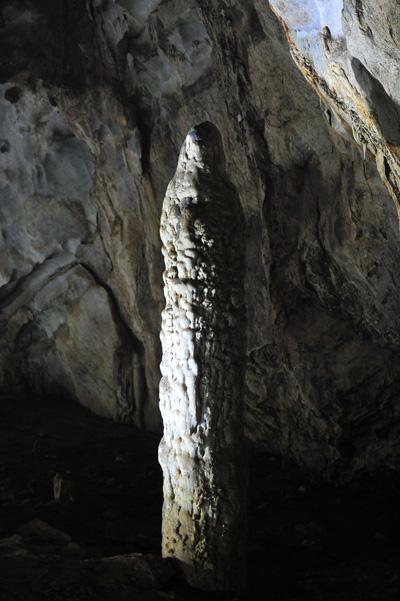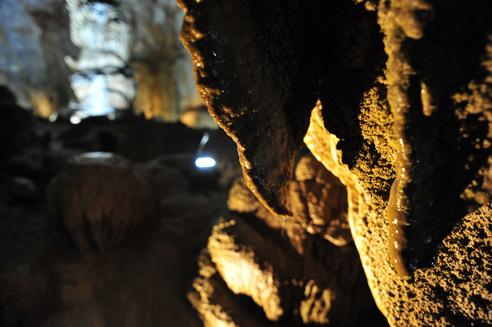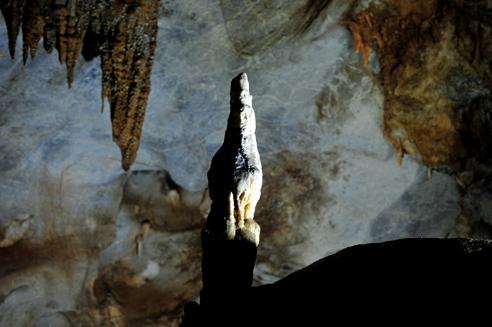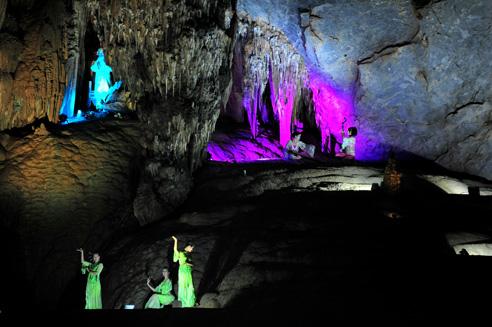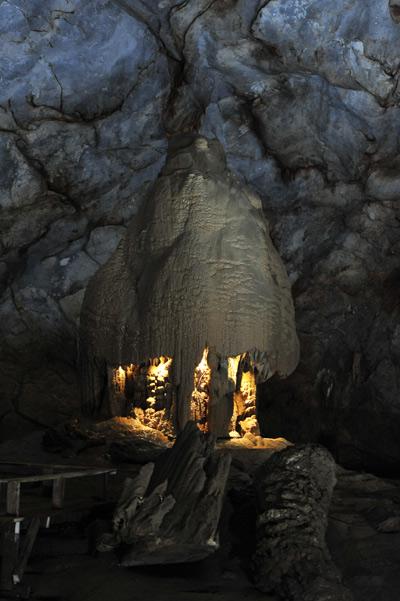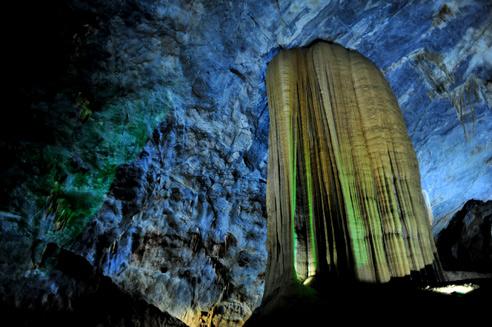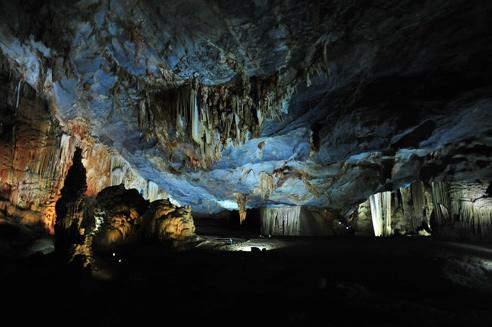Paradise Cave (Thien Duong Cave) is newly-discovered cave in Quang Binh Province. Its length is 31 km. The widest spot is about 150 meters. It brings a fantastic beauty that make tourists in Vietnam Tourism praise.
|
Thursday, January 31, 2013
Paradise cave - magical beauty
It's the longest dry cave in Asia with magnificent stalactites.
Monday, January 28, 2013
Along the Saigon River
The VIP speed boat eventually glided into the wharf, it was forty-five minutes late, and we had been waiting impatiently for it to arrive so that we could begin our journey along the Saigon River to the Cu Chi tunnel historical site.
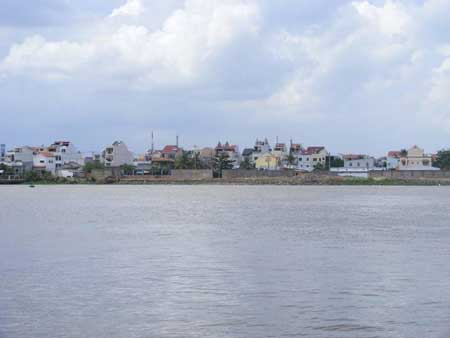
Sai Gon River. (Photo: Internet)
The boat looked to be full but our party of six adults and two children were eventually accommodated in the front of the boat, under the awning which shielded us from the hot overhead sun. The children were delighted that they were able to utilize the pilot’s seat and for most of the journey, each way, they took turns on one of the adult’s laps, the wind created by the high speed boat blowing their hair back. They were entranced by the foam created by the turbulence of the boat which climbed almost to the deck on each side.
The Saigon River is a busy waterway with heavily laden barges, smaller pilot boats, fishing boats and local ferries all utilizing this water course. Dense blankets of water hyacinths floated along the top of the river, the flowers still in bud; these aquatic weeds are a curse to the propellers of high speed boats and our driver did his best to avoid the thickest areas. The weed is harvested by locals who make attractive baskets in varying designs and quality to sell at markets.
The boat took an hour and a half to reach its destination; it was an enjoyable ride with the distractions of the daily life of the river continually changing. We passed through the industrial city and into the countryside where farmers were seen working in the vibrant green paddy fields and laborers tended the forests of rubber trees.
The tunnels of Cu Chi are an immense network of connecting underground tunnels located in the Cu Chi District of HCMC. They are part of a much larger network of tunnels that extend throughout the country. This section of the tunnels has been turned into a War Memorial Park and is very popular with tourists who can get some small idea of what it must have been like for the Vietnamese guerrillas who lived, worked and fought inside the very narrow confines of the tunnels. Some portions of the tunnels have been enlarged so that they can accommodate the larger stature of the modern day tourist and, for the adventurous and those that do not suffer from claustrophobia, crawling through these shafts is one of the options available.
It is almost impossible to believe that both men and women lived in these confined spaces for months, even years, fighting off not only the American soldiers but dangerous insects such as scorpions, ants, poisonous centipedes, spiders and rodents, diseases facilitated by the lack of fresh air and healthy food and water, particularly malaria, which was the second largest cause of death after battle wounds.
Tourists are able to witness the booby traps, fashioned from basic materials but used to deadly effectiveness. They can fire a variety of Vietnamese War Era weapons, which include the AK47 and M16 rifles and the M60 machine gun, however, there is a need to take good ear protection, it is extremely noisy and that supplied is not altogether effective.
It is a grueling glimpse into the lives of the guerrilla fighters in their resistance against the American forces and it was a relaxing getaway to seat ourselves next to the fast flowing current of the river while being served a traditional Vietnamese lunch. The small restaurant, set on a platform above the reeded banks of the river and open to any light breeze which could permeate the mid-day heat, provided a relief from the horrors of war.
The Saigon River is a busy waterway with heavily laden barges, smaller pilot boats, fishing boats and local ferries all utilizing this water course. Dense blankets of water hyacinths floated along the top of the river, the flowers still in bud; these aquatic weeds are a curse to the propellers of high speed boats and our driver did his best to avoid the thickest areas. The weed is harvested by locals who make attractive baskets in varying designs and quality to sell at markets.
The boat took an hour and a half to reach its destination; it was an enjoyable ride with the distractions of the daily life of the river continually changing. We passed through the industrial city and into the countryside where farmers were seen working in the vibrant green paddy fields and laborers tended the forests of rubber trees.
The tunnels of Cu Chi are an immense network of connecting underground tunnels located in the Cu Chi District of HCMC. They are part of a much larger network of tunnels that extend throughout the country. This section of the tunnels has been turned into a War Memorial Park and is very popular with tourists who can get some small idea of what it must have been like for the Vietnamese guerrillas who lived, worked and fought inside the very narrow confines of the tunnels. Some portions of the tunnels have been enlarged so that they can accommodate the larger stature of the modern day tourist and, for the adventurous and those that do not suffer from claustrophobia, crawling through these shafts is one of the options available.
It is almost impossible to believe that both men and women lived in these confined spaces for months, even years, fighting off not only the American soldiers but dangerous insects such as scorpions, ants, poisonous centipedes, spiders and rodents, diseases facilitated by the lack of fresh air and healthy food and water, particularly malaria, which was the second largest cause of death after battle wounds.
Tourists are able to witness the booby traps, fashioned from basic materials but used to deadly effectiveness. They can fire a variety of Vietnamese War Era weapons, which include the AK47 and M16 rifles and the M60 machine gun, however, there is a need to take good ear protection, it is extremely noisy and that supplied is not altogether effective.
It is a grueling glimpse into the lives of the guerrilla fighters in their resistance against the American forces and it was a relaxing getaway to seat ourselves next to the fast flowing current of the river while being served a traditional Vietnamese lunch. The small restaurant, set on a platform above the reeded banks of the river and open to any light breeze which could permeate the mid-day heat, provided a relief from the horrors of war.
Thursday, January 24, 2013
The northern coast of Vietnam
Although largely devoid of beaches, Vietnam’s northern coast boasts one of the country’s foremost attractions, and one of the most vaunted spots in all of Southeast Asia – the mystical scenery of Halong Bay, where jagged emerald islands jut out of the sea in their thousands. Heading in by boat, you approach wave after wave of hidden bays, needle-sharp ridges and cliffs of ribbed limestone.
The waters here are patrolled by squadrons of attractive, old-fashioned tourist junks, on which you’ll be able to spend a night at sea; wonderful Cat Ba island is another great place to stay. You’ll find similar karst scenery inland around the small city of Ninh Binh, while other notable sights in the area are the colonial buildings of Hai Phong and the caves around Dong Hoi.

The northern coast stretches all the way from the DMZ to the Chinese border. Heading north from the DMZ (the Demilitarized Zone) the first stretch is hemmed in by the jagged Truong Son Mountains, which separate Vietnam from Laos.
Here, Vietnam shrinks to a mere 50km wide and is edged with sand dunes up to 80m high, marching inland at a rate of 10m per year despite efforts to stabilize them with screw-pine and cactus.

The first place of note on this stretch is Dong Hoi, a largely uninteresting city, but one that serves as a jump-off point for the spectacular cave of Phong Nha. This was regarded as the largest cave in the land, until another was discovered nearby – Son Doong cave, yet to be fully charted but already held to be the largest in the world.
The area north of Dong Hoi is one of the poorest in Vietnam, and has little to detain the traveller; however, the mountains brushing the Lao border are home to a number of unique animal species, including the elusive saola ox and the more numerous giant muntjac deer.
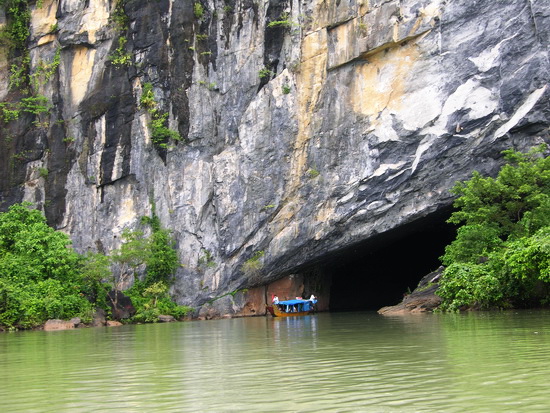
The only place that sees travellers in any number is Vinh, another rather dull place, but a logical stopover on this long stretch; you may care to track down Ho Chi Minh’s birthplace in the nearby village of Kim Lien.
Despite the presence of these attractions, the vast majority of tourists make a bee-line from Hue to Ninh Binh. This is yet another unattractive northern city, but such is the wealth of nearby sights that visitors tend to stay for at least a couple of days; said attractions include majestic karst scenery, underground rivers that can be paddled through by boat, an ancient capital city and Vietnam’s largest temple complex.

From Ninh Binh, most travellers push straight on north to Hanoi. However, it’s quite possible to head directly from here towards Halong Bay, via the buzzing city of Hai Phong – one of the largest in Vietnam, and infinitely more appealing than most northern cities thanks to great colonial-era architecture and a young, friendly populace.
Then, of course, there’s Halong Bay itself. A doyen of local tourist literature, you’ll most likely have seen dozens of images of this unbelievably scenic place long before your arrival – happily, it really is that pretty. Vietnam tourism now rivals fishing as the prime activity, but the bay retains a certain authenticity, and its generous proportions are enough to swallow up the hordes or visitors, for the time being.
Despite the presence of these attractions, the vast majority of tourists make a bee-line from Hue to Ninh Binh. This is yet another unattractive northern city, but such is the wealth of nearby sights that visitors tend to stay for at least a couple of days; said attractions include majestic karst scenery, underground rivers that can be paddled through by boat, an ancient capital city and Vietnam’s largest temple complex.

From Ninh Binh, most travellers push straight on north to Hanoi. However, it’s quite possible to head directly from here towards Halong Bay, via the buzzing city of Hai Phong – one of the largest in Vietnam, and infinitely more appealing than most northern cities thanks to great colonial-era architecture and a young, friendly populace.
Then, of course, there’s Halong Bay itself. A doyen of local tourist literature, you’ll most likely have seen dozens of images of this unbelievably scenic place long before your arrival – happily, it really is that pretty. Vietnam tourism now rivals fishing as the prime activity, but the bay retains a certain authenticity, and its generous proportions are enough to swallow up the hordes or visitors, for the time being.
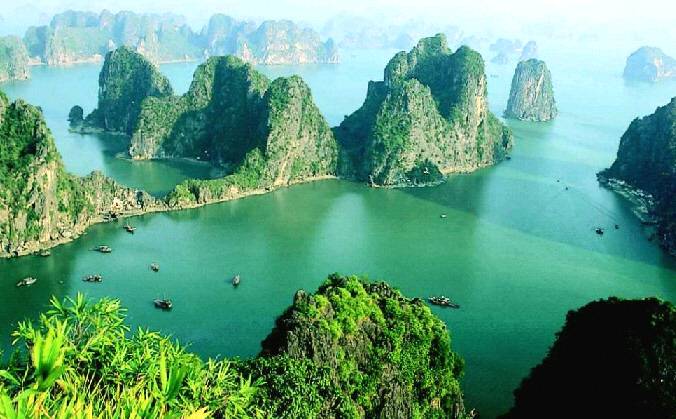
Many overnight aboard a traditional wooden junk; their tea-coloured sails are just for show since almost all vessels are motor-driven, but there’s a timeless, romantic air to floating amongst pristine moonlit peaks. By far the largest island in the bay, the wonderful Cat Ba makes an appealing base for exploring the area with some fine scenery as well as being home to Cat Ba National Park, a forest and maritime reserve that requires the usual mix of luck and dedication to see anything larger than a mosquito.
Monday, January 21, 2013
Fried wonton dumplings – Hoi An favorite
The many tourists who head to Hoi An, the ancient town with its glistening lights of lanterns in old houses, should not miss out on trying one of Hoi An’s specialties, hoanh thanh chien (fried wonton dumplings).
Wonton dumplings, essentially the same as the Chinese variety, is served up in soup or deep-fried. But imo Hoi An wontons, deep fried and covered in a salsa-like topping of vegetables and sweet and sour shrimp are crispy, mouth-watering works of art.

Fried wonton dumplings (Hoanh thánh chiên) is a specialty in Hoi An Photo:Internet
However, to make the dish, makers need to be skillful. Fresh shrimp will be peeled off covers, then grinded and mixed with husked pork and sliced onion as well as spices for about 30 minutes. The next move is to spread wonton, put the mixture of shrimp, pork and spices on it and wrap them. And makers then just cook them in oil.
People often added fried tomatoes and coriander on the fried wonton dumplings to make it more good-looking and tasty.
The last phase is making the sauce. Eaters can enjoy it with chili sauce mixed with soya sauce and vinegar. Salad and mayonnaise are also needed to feast diners’ tongues.
Friday, January 18, 2013
Buckwheat Flower season in Ha Giang
Have you ever seen sunset light fall into the mountain village? Haveyou ever seen sunset light fall into the upland fields of buckwheat flowers? Have you ever encountered "fairy" sunlight? Hurry up! Travel to Ha Giang, now!
Vietnam Tourism will take you go to buckwheat flower season at north pole's Vietnam - Dong Van stone plateau, Ha Giang Province. The plateau was recognized by the UNESCO as one of the 77 geological parks in the world and the second in Southeast Asia.
With diverse cultures and traditions of nearly 20 ethnic groups, Dong Van plateau is an interesting destination for tourists. These ethnic minorities live on cultivating rice along the basins of the Nho Que River and corn on the rocky mountain slopes. Life may be tough, but most of the local ethnic groups still stick to their century-old traditions.

Dong Van stone plateau with extreme winter is still bright with buckwheat flowers's petals each winter.
  Each winter, in the cold wind, type of white, pink small flowers bloom on the fields, slopes.   The cold and deserted plateau wear a new shirt color welcome yellow sunlight. The cold and deserted plateau wear a new shirt color welcome yellow sunlight. 
Vitality of the plateau
|
Tuesday, January 15, 2013
Mong ethnic group celebrates traditional New Year
Mong ethnic minority residents of Hang Kia Village, nestled in northern Hoa Binh province’s Mai Chau Valley, are celebrating their Lunar New Year (Tet) Festival, starting on the first day of the 12th lunar month.

Travellers to Hang Kia village, Mai Chau valley, Hoa Binh must brave foggy paths

The village, surrounded by fog, experiences cold weather

During the Tet holiday, children have the chance to wear new clothes


…and new shoes…


…and play folk games with each other




Adults stay indoors, drinking wine around a fire

Children also need warming up
Tet arrives for the Mong people one month before the similar festival of the Kinh, which make up the majority of Vietnamese population.
Despite the extremely cold weather, thick fog and drizzle, local children, dressed in colourful clothes, step out of their houses, enjoying the atmosphere of spring that is spreading through every corner of the village.
Look at the beauty of spring in the northern Highlands:
Despite the extremely cold weather, thick fog and drizzle, local children, dressed in colourful clothes, step out of their houses, enjoying the atmosphere of spring that is spreading through every corner of the village.
Look at the beauty of spring in the northern Highlands:

Travellers to Hang Kia village, Mai Chau valley, Hoa Binh must brave foggy paths

The village, surrounded by fog, experiences cold weather

During the Tet holiday, children have the chance to wear new clothes


…and new shoes…


…and play folk games with each other




Adults stay indoors, drinking wine around a fire

Children also need warming up
Historical monuments in Hue
Hue is a representation of the vanished Vietnamese feudal empire in the early 19th century. The place’s monuments recognized by UNESCO only show an intact and well defended capital city in a form of its architecture, urban planning and construction.
With a deep history popular around the world, Vietnam has become one of the main tourist destinations for its historic monuments. The country’s monuments acclaimed by the United Nations Educational, Scientific and Cultural Organization (UNESCO) are particularly located in Hue city, which is as equally famous as other cities for its breathtaking travel destinations.
Hue is located in central Vietnam, between two huge and well known cities, Ho Chi Minh City (formerly Saigon) and Hanoi. It is approximately 1100 km north from Hồ Chí Minh City, the largest city of Vietnam and 700 km from the south of Hanoi.
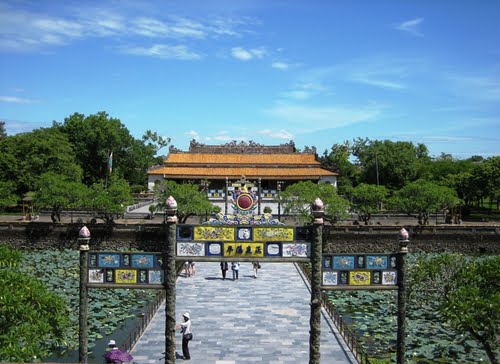
Today, Hue is a representation of the vanished Vietnamese feudal empire in the early 19th century. The place’s monuments recognized by UNESCO only show an intact and well defended capital city in a form of its architecture, urban planning and construction. For these historical monuments, it is also recognized as one of the best travel destinations in Vietnam.
Part of the complex of historic monuments, Hue’s prime attractions, is the Imperial Citadel. The citadel is the courtyard of Ngo Mon, the entrance of the city from the south. One of the more peaceful area in Vietnam due to its size, the citadel is a mixed of different historical buildings educating tourist about art and costumes from different Vietnam historical periods.

Not very far from the courtyard is the Ngọ Môn. As mentioned earlier, it is the southern entrance of Hue. It is believed to be reserved only for the emperor’s use and was the main entrance to the Imperial Enclosure. While other officials were then not allowed inside the citadel, the Emperor addressed them at the top of the Ngọ Môn gate.
Another palace included inside the complex of monuments is Thái Hòa Palace. It was the emperor's coronation hall and also the space where the emperor received foreign guest particularly dignitaries.
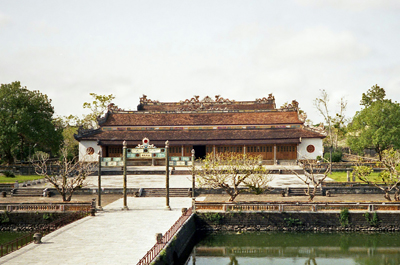 Famous in movies, the Forbidden Purple City can also be seen in Hue. It is located at the rear area of the Thai Hoa Palace. Little is left of the Forbidden Purple City because it was destroyed in 1968. Nevertheless, more tourist still visit the place because of its history as articulated in the remains of the Mandarin Palaces located on both sides of the area.
Tourists who are fond of historical insights such as these may get a hand full while visiting the historic monuments of Hue.
To experience Vietnam’s history through Hue’s historic monuments as well as the other must-visit places in Vietnam, tourists can take travel packages. The tour packages start from as low as $100 USD to $1000 per person, depending on the length of the tour and where you intend to stay.
These packages tour tourist around Vietnam as well as give a historical background about the different monuments, palaces, museums and other vacation spots.
Experience the historical monuments at Hue with www.minmaxtravel.com, one the primmest travelling companies that provide memorable tours to all best travel destinations in Vietnam.
|
How it feels rainy season
As the scorching months of summer slid by, sticky and humid in the Center of Vietnam, I looked forward to cooler temperatures and the relief of the monsoon rains.
A few months of indoor living, poncho motorbikes, damp clothes and sheets would do everyone good I figured- and by the time the heat rolled around again we’d all be ready for it. As October rolled in, so did the rain. But then something strange happened - it rolled back out as quick as it came.
A few days turned weeks of beautiful weather, and all the people who were dreading the rainy season rejoiced in the continuous beach weather, warm sun and ability to dry washing in a day instead of a week.
 Tra Que Herb Village soaking in the sunshine Tra Que Herb Village soaking in the sunshine
But as the months passed by, October turned November, November December and the rains never came. I’d been cynically looking forward to some sort of intuitive months of antisocial living trapped indoors by the waterfalls outside- but if you looked out the window on any given day in Danang and Hoi An, the only thing you’d see was the sun.
While some people continued the sun dance, others looked towards the future and dreaded what the next summer might bring.
Extended expats recalled the past 4-8 years of weather and claimed that this endless summer had never been experience before, at least as far as they could recall. Some claimed it was an 8 year pattern of weather while others say their beach prayers were being answered as they soaked in the December UV rays.
 An Bang Beach in the middle of the winter An Bang Beach in the middle of the winter
Tourists expecting soaking conditions certainly rejoiced in their good luck in visiting Vietnam’s Center during this ‘rainy’ season- and they enjoyed all the perks of the high season (weather) with the perks of the low season (cheap rates and less crowds).
As for me, I’m still trying to figure out whether it’s time to plant the garden yet, or if all my seedlings will be washed away by the monsoons that are still waiting to unleash on the midsection of Vietnam’s coastline.
On one hand we are all enjoying the amazing Central Coast beaches, soaking in the rays instead of mopping up the soaked floors, but on the other hand we dread the worst to come. Hydroelectric dams powering our fridges, fans and A/C’s during the 40 degree nights aren’t going to run too well when they have no water to power them.
Nightmares of rolling power cuts and extended outages may be a reality, but only time will tell. So though we are thankful for the beautiful weather that we have experienced this ‘rainy season’- bring on the rains, at least for a few weeks, no?
Short Summary:
As January rolls into Central Vietnam, locals and expats alike enjoy the absence of this years rainy season- but wonder what it will bring in the months to come.
|
Subscribe to:
Posts (Atom)
